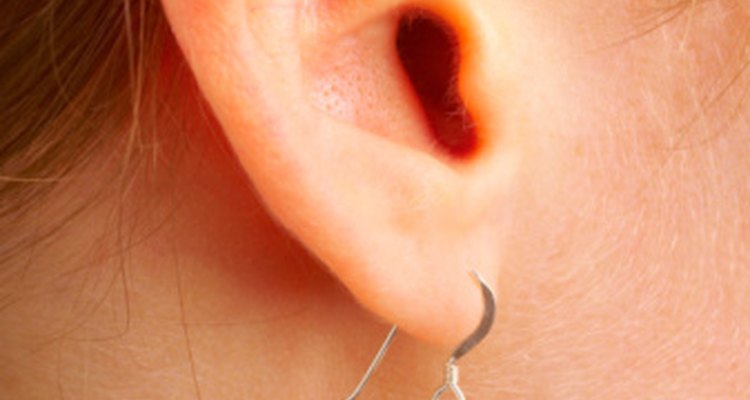
Metal earrings are a common fashion accessory in society. They are available in thousands of styles and work to tone up or tone down any outfit. Unfortunately, interactions with some common substances in our environment can turn a pair of beautiful earrings from gold or silver to black or green. If this happens to your earrings, there are several common culprits that may be responsible for the discoloration.
Make-Up
Contact with make-up on the wearer's skin or clothing is one of the most common causes of earrings changing color. Cosmetics contain chemical compounds including zinc oxide, titanium dioxide, ferric oxide and calamine that are harder that the chemical compounds that make up your jewelry. A phenomenon known as metallic abrasion takes place when these hard chemical compounds rub or wear off tiny particles of the metal that makes up the earrings, causing a black dust to form and often smudge the wearer's skin. To prevent metallic abrasion, avoid make-up that contains the chemical compounds mentioned above and wash your ears with soap and water prior to putting on earrings.
Perspiration
Contact with moisture can cause the metals that make up your earrings to corrode and subsequently change color. Because humans possess thousands of sweat glands on their skin, the fat and fatty acids present in perspiration can cause corrosion in metal earrings. While some people think this will only happen to silver jewelry, it can happen to gold as well, with the exception of 24 karat, pure gold. This is because earrings that are made of less than 24 karat gold are composed of part pure gold and part alloys; the alloys in the earrings are what will corrode, while the pure gold will remain unscathed. To prevent corrosion due to your own perspiration, place a small amount of zinc oxide-free absorbent powder onto your skin before you put on your earrings.
Hydrogen Sulfide
Earrings made up of sterling silver, and sometimes gold, may tarnish when they come into contact with hydrogen sulfide. Hydrogen sulfide may be present in smoke from raw fuels, such as oil or coal, or in polluted air. It may also be found inside of some foods with strong smells such as eggs, onions, pickles and some fish. When the earrings begin to tarnish, they will begin to lose their color and take on a yellowish tint that will later transform into a gray or black color. You can remove tarnish due to contact with hydrogen sulfide from your earrings with a cleaning polish often available for purchase at sterling silver jewelry manufacturers.
Medications
Certain medications can alter the acidity of your skin, causing earrings to change color. Antibiotics are one of the most likely medications to cause earrings to tarnish. To avoid ruining your earrings, try to wear only earrings made of 18 karat gold or higher while taking medicine.
Related Articles

Jewelry & Skin Discoloration

Earrings That Don't Hurt Your Ears

Does Stainless Steel Jewelry Turn Green?

Harmful Effects of Wearing Magnetic ...

Metal Detox & Acne

Reactions to Nose Piercings

How to Remove Betadine From the Skin

How to Get Rid of Static Electricity in ...

Information on Colloidal Silver Cream ...

Health Benefits of Organic Foods Vs. ...

How to Clean Sterling & Turquoise ...

How to Make Homemade Silver Jewelry ...

Does Sweating From Exercise Help With ...

How to Remove a Labret Piercing

What Is PABA in Sunscreen?

Homemade Gold Jewelry Cleaner

Consequences of Wearing Grillz

How to Clean the Green Discoloring on ...

If Chicken Smells Bad Can You Still ...

How to Use Colloidal Silver to Kill ...
References
Writer Bio
Dawn Westin is an experienced professional writer who has contributed articles to publications including "South Magazine" and "The Inkwell." She holds a BA in English and professional communications from Armstrong Atlantic State University and currently takes courses at Georgia Southern University in hopes of soon enrolling in medical school.
Photo Credits
Jupiterimages/Photos.com/Getty Images